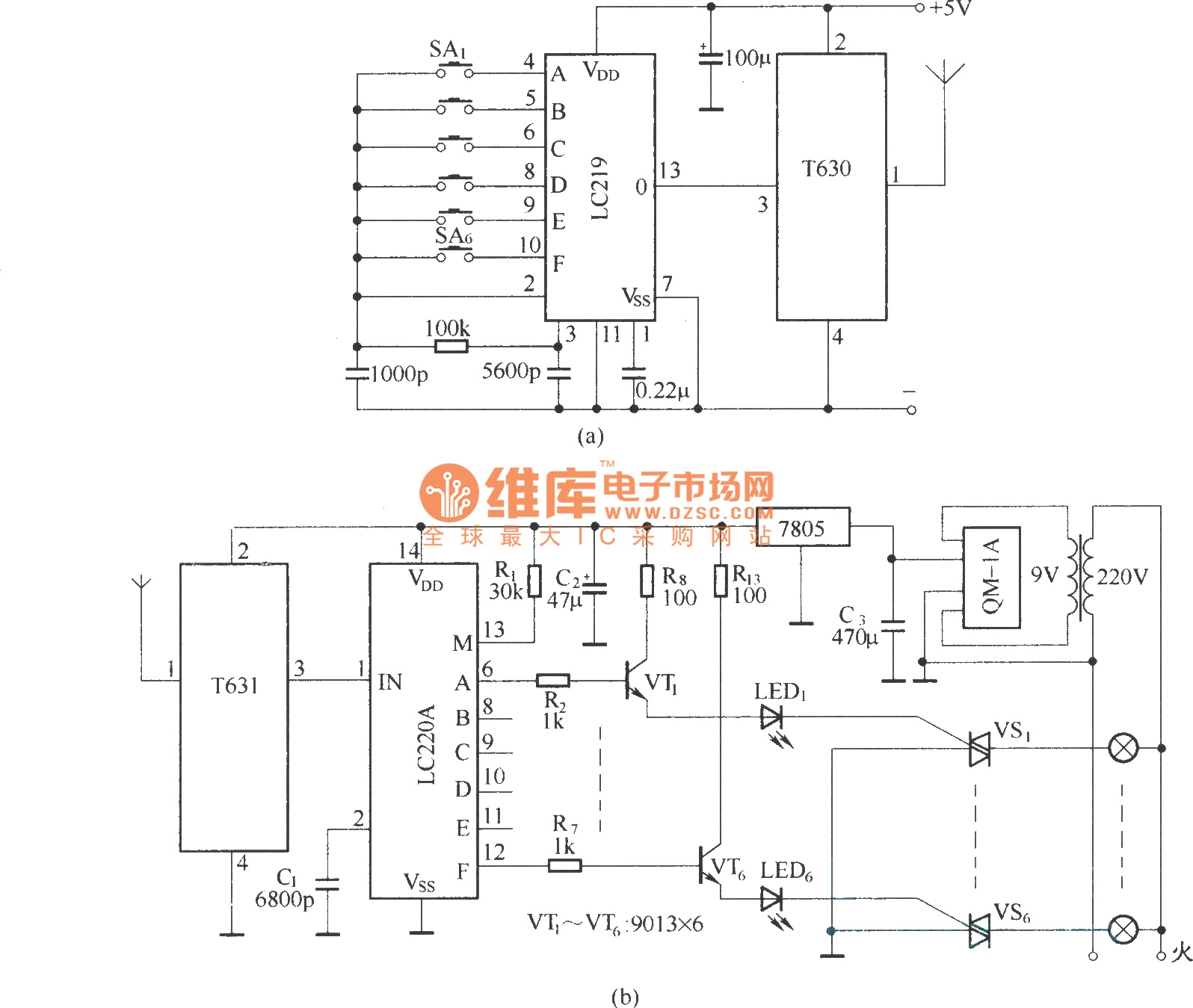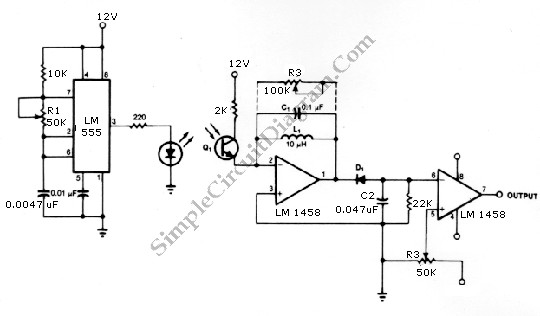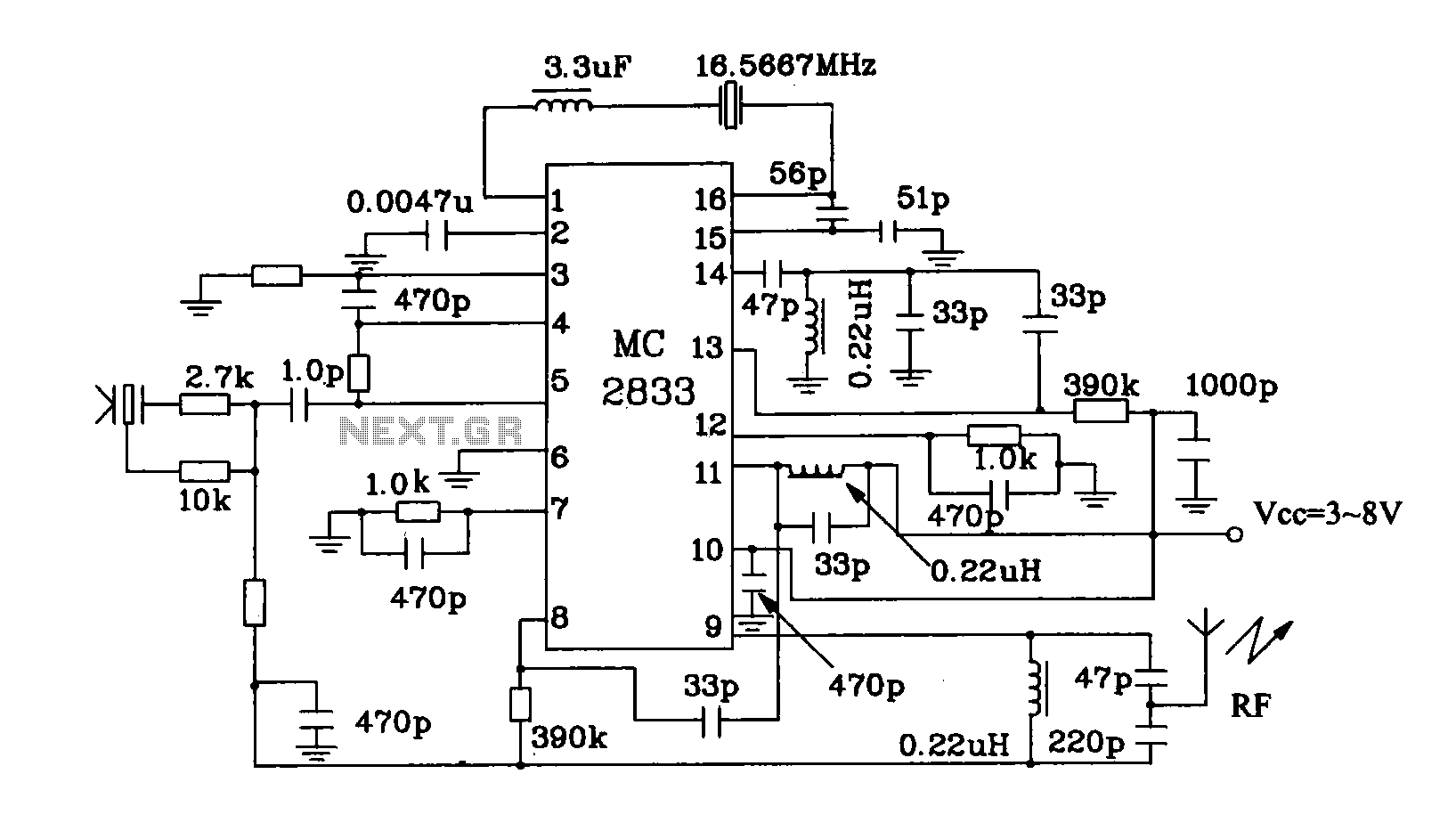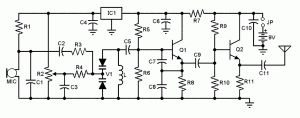
Long Range FM Transmitter
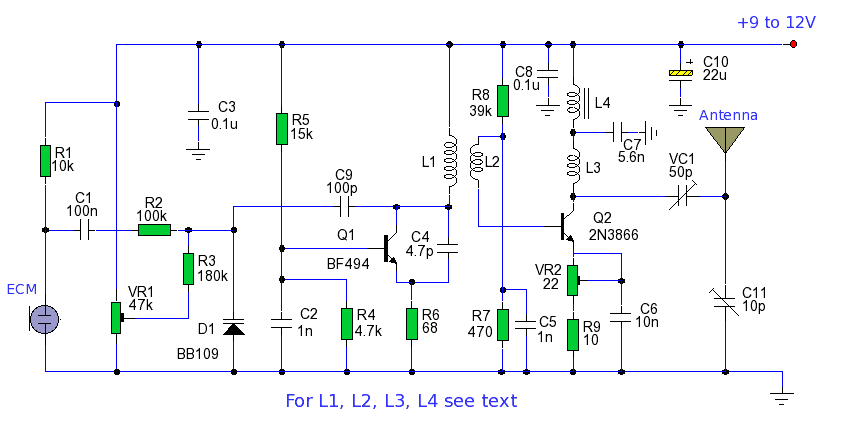
The power output of many transmitter circuits is low due to the absence of power amplifier stages. The transmitter circuit presented here includes an additional RF power amplifier stage after the oscillator stage, which elevates the power output to 200-250 milliwatts. When paired with a well-matched 50-ohm ground plane antenna or a multi-element Yagi antenna, this transmitter can achieve reasonable signal strength over distances of approximately 2 kilometers. The circuit is based around transistor T1 (BF494), functioning as a basic low-power variable-frequency VHF oscillator. A varicap diode circuit is integrated to adjust the transmitter frequency and enable frequency modulation via audio signals. The oscillator output is approximately 50 milliwatts. Transistor T2 (2N3866) serves as a VHF-class A power amplifier, amplifying the oscillator signal power by four to five times, resulting in 200-250 milliwatts of power at the collector of transistor T2. For optimal performance, it is recommended to construct the circuit on a high-quality glass epoxy board and enclose the transmitter in an aluminum case. The oscillator stage should be shielded using an aluminum sheet. Coil winding details are specified below: Potentiometer VR1 is utilized to adjust the fundamental frequency, while potentiometer VR2 is designated for power control. To ensure a hum-free operation, the transmitter should be powered by a 12V rechargeable battery pack composed of 10 x 1.2-volt Ni-Cd cells. Transistor T2 must be mounted on a heat sink. It is crucial not to activate the transmitter without a matching antenna. Both trimmers (VC1 and VC2) should be adjusted for maximum transmission power, and potentiometer VR1 should be set to establish the fundamental frequency near 100 MHz. WARNING: Transmitting on the UK Commercial FM band is illegal in the UK; this circuit is provided for educational purposes only.
The transmitter circuit design incorporates several critical components and configurations to ensure efficient operation and reliable performance. The choice of transistors T1 (BF494) and T2 (2N3866) is significant due to their suitability for VHF applications, offering low noise and high gain characteristics. The use of a varicap diode allows for fine-tuning of the oscillator frequency, which is essential for achieving the desired modulation and signal clarity.
The power amplifier stage, formed by transistor T2, is designed to handle the increased power output without distortion. The specified power output range of 200-250 milliwatts is sufficient for short-range communication, making this circuit ideal for hobbyists and educational projects. The inclusion of a heat sink for transistor T2 is crucial, as it dissipates heat generated during operation, maintaining performance stability and preventing thermal overload.
The circuit layout should be carefully implemented on a glass epoxy board to minimize parasitic capacitance and ensure signal integrity. The aluminum casing not only provides physical protection but also serves as an electromagnetic shield, reducing interference from external sources. The use of a 50-ohm antenna is critical for impedance matching, which maximizes power transfer and minimizes signal reflection.
Adjustments via potentiometers VR1 and VR2 allow users to customize the transmitter’s frequency and output power, respectively. The trimmers VC1 and VC2 are essential for fine-tuning the circuit to achieve optimal transmission conditions. Powering the circuit with a 12V rechargeable battery pack ensures portability and convenience while maintaining a stable voltage supply.
Overall, this transmitter circuit presents a practical solution for low-power VHF transmission, suitable for various applications in the field of electronics and communications. Care should be taken to adhere to legal regulations regarding transmission frequencies and power levels to avoid interference with licensed services.The power output of many transmitter circuits are very low because no power amplifier stages are incorporated. The transmitter circuit described here has an extra RF power amplifier stage, after the oscillator stage, to raise the power output to 200-250 milliwatts.
With a good matching 50-ohm ground plane antenna or multi-element Yagi antenna, thi s transmitter can provide reasonably good signal strength up to a distance of about 2 kilometres. The circuit built around transistor T1 (BF494) is a basic low-power variable-frequency VHF oscillator. A varicap diode circuit is included to change the frequency of the transmitter and to provide frequency modulation by audio signals.
The output of the oscillator is about 50 milliwatts. Transistor T2 (2N3866) forms a VHF-class A power amplifier. It boosts the oscillator signal power four to five times. Thus, 200-250 milliwatts of power is generated at the collector of transistor T2. For better results, assemble the circuit on a good-quality glass epoxy board and house the transmitter inside an aluminium case. Shield the oscillator stage using an aluminium sheet. Coil winding details are given below: Potentiometer VR1 is used to vary the fundamental frequency whereas potentiometer VR2 is used as power control.
For hum-free operation, operate the transmitter on a 12V rechargeable battery pack of 10 x 1. 2-volt Ni-Cd cells. Transistor T2 must be mounted on a heat sink. Do not switch on the transmitter without a matching antenna. Adjust both trimmers (VC1 and VC2) for maximum transmission power. Adjust potentiometer VR1 to set the fundamental frequency near 100 MHz. WARNING: Transmitting on the UK Commercial FM band is also illegal in the UK, please see the general disclaimer. This circuit is shown for educational purposes only. 🔗 External reference
The transmitter circuit design incorporates several critical components and configurations to ensure efficient operation and reliable performance. The choice of transistors T1 (BF494) and T2 (2N3866) is significant due to their suitability for VHF applications, offering low noise and high gain characteristics. The use of a varicap diode allows for fine-tuning of the oscillator frequency, which is essential for achieving the desired modulation and signal clarity.
The power amplifier stage, formed by transistor T2, is designed to handle the increased power output without distortion. The specified power output range of 200-250 milliwatts is sufficient for short-range communication, making this circuit ideal for hobbyists and educational projects. The inclusion of a heat sink for transistor T2 is crucial, as it dissipates heat generated during operation, maintaining performance stability and preventing thermal overload.
The circuit layout should be carefully implemented on a glass epoxy board to minimize parasitic capacitance and ensure signal integrity. The aluminum casing not only provides physical protection but also serves as an electromagnetic shield, reducing interference from external sources. The use of a 50-ohm antenna is critical for impedance matching, which maximizes power transfer and minimizes signal reflection.
Adjustments via potentiometers VR1 and VR2 allow users to customize the transmitter’s frequency and output power, respectively. The trimmers VC1 and VC2 are essential for fine-tuning the circuit to achieve optimal transmission conditions. Powering the circuit with a 12V rechargeable battery pack ensures portability and convenience while maintaining a stable voltage supply.
Overall, this transmitter circuit presents a practical solution for low-power VHF transmission, suitable for various applications in the field of electronics and communications. Care should be taken to adhere to legal regulations regarding transmission frequencies and power levels to avoid interference with licensed services.The power output of many transmitter circuits are very low because no power amplifier stages are incorporated. The transmitter circuit described here has an extra RF power amplifier stage, after the oscillator stage, to raise the power output to 200-250 milliwatts.
With a good matching 50-ohm ground plane antenna or multi-element Yagi antenna, thi s transmitter can provide reasonably good signal strength up to a distance of about 2 kilometres. The circuit built around transistor T1 (BF494) is a basic low-power variable-frequency VHF oscillator. A varicap diode circuit is included to change the frequency of the transmitter and to provide frequency modulation by audio signals.
The output of the oscillator is about 50 milliwatts. Transistor T2 (2N3866) forms a VHF-class A power amplifier. It boosts the oscillator signal power four to five times. Thus, 200-250 milliwatts of power is generated at the collector of transistor T2. For better results, assemble the circuit on a good-quality glass epoxy board and house the transmitter inside an aluminium case. Shield the oscillator stage using an aluminium sheet. Coil winding details are given below: Potentiometer VR1 is used to vary the fundamental frequency whereas potentiometer VR2 is used as power control.
For hum-free operation, operate the transmitter on a 12V rechargeable battery pack of 10 x 1. 2-volt Ni-Cd cells. Transistor T2 must be mounted on a heat sink. Do not switch on the transmitter without a matching antenna. Adjust both trimmers (VC1 and VC2) for maximum transmission power. Adjust potentiometer VR1 to set the fundamental frequency near 100 MHz. WARNING: Transmitting on the UK Commercial FM band is also illegal in the UK, please see the general disclaimer. This circuit is shown for educational purposes only. 🔗 External reference
